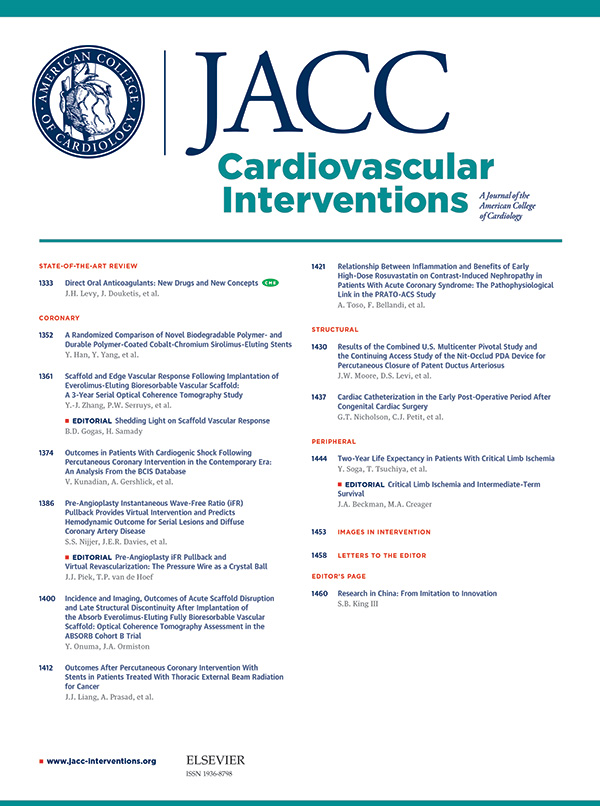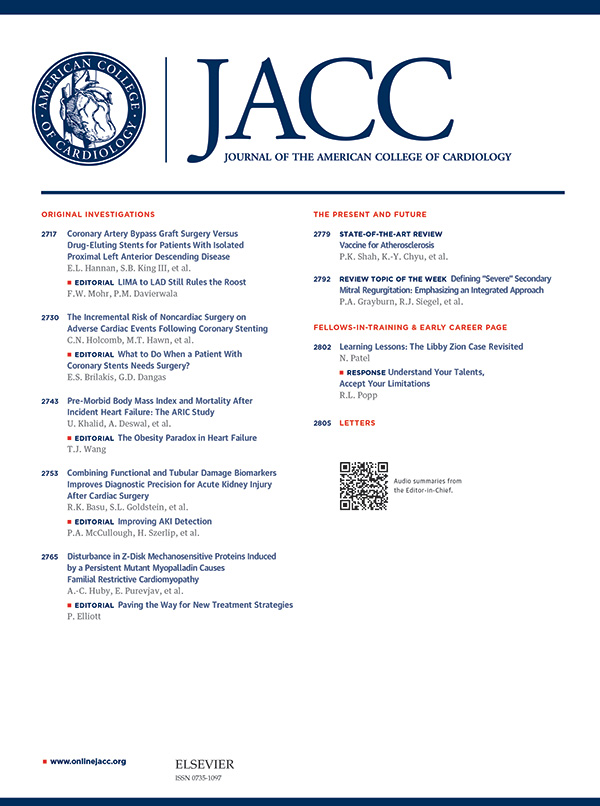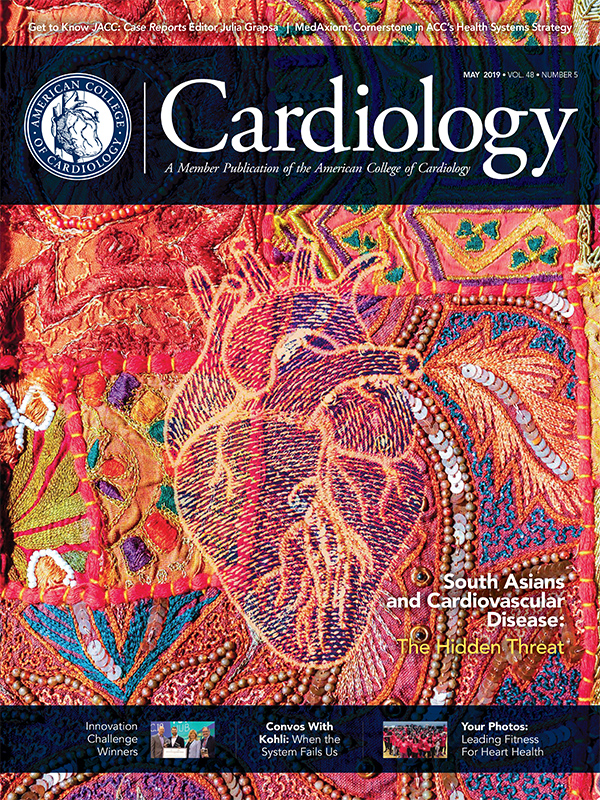JACC in a Flash
Featured topics and Editors' Picks from all of ACC's JACC Journals.
Is ICU Care Necessary For STEMI Patients?

Although the majority of STEMI patients are treated in the ICU after undergoing PCI, only 16 percent develop complications that require ICU care, according to a study published in JACC: Cardiovascular Interventions.
Jay S. Shavadia, MB Bch, et al., used ACC's Chest Pain – MI Registry to examine patterns of ICU use in STEMI patients ≥65 years who had been treated with primary PCI. The researchers stratified data into three categories based on the timing of reperfusion: early (first medical contact [FMC] to device time ≤60 minutes); intermediate (61-90 minutes); or late (≥90 minutes).
Of 19,507 STEMI patients at 707 hospitals, 16,047 (82.3 percent) were treated in an ICU with a median stay of one day. The median FMC to device time was 79 minutes, with 20 percent of patients receiving early contact, 44.8 percent intermediate and 33.2 percent late reperfusion.
Overall, 3,159 patients (16.2 percent) developed complications that required ICU care, including death (3.7 percent); cardiac arrest (3.7 percent); shock (8.7 percent); stroke (0.9 percent); high-grade atrioventricular block (4.1 percent); and respiratory failure (5.7 percent).
There was no difference in ICU care between patients with early, intermediate or late reperfusion times. The complication rate was lower in the early vs. the late treatment groups (13.4 percent vs. 18.7 percent, respectively).
The researchers concluded that although >80 percent of STEMI patients receive ICU care after primary PCI, the risk of developing a complication that requires an ICU stay is 16 percent. "Improved prediction aimed at the timely identification of patients at greatest risk for developing complications could help in safely rationalizing ICU triage decisions," they conclude.
In an accompanying editorial, Suartcha Prueksaritanond, MD, and Ahmed Abdel-Latif, MD, PhD, write that a "new approach" is needed to determine which STEMI patients should be admitted to the ICU, adding this is "particularly important as the overall health care cost continues to grow and calls for optimal resource utilization prevail."
Shavadia JS, Chen AY, Fanaroff AC, et al. JACC Cardiovasc Interv 2019;12:709-17.
New Expert Consensus Document Proposes Optimal Strategies For VHD Systems of Care

A new expert consensus system of care document proposes strategies to optimize care for patients with valvular heart disease (VHD). The document was developed by the ACC, American Association for Thoracic Surgery, American Society of Echocardiography, Society for Cardiovascular Angiography and Interventions, and Society of Thoracic Surgeons, and published in the Journal of the American College of Cardiology.
The document is intended to "initiate a discussion" about systems of care for patients with VHD to optimize outcomes and improve overall care. It underscores best practices from the 2014 VHD guideline and 2017 focused update and is a companion to the 2018 expert consensus systems of care document on TAVR and the 2017 ACC Expert Consensus Decision Pathway on the Management of Mitral Regurgitation.
Specifically, the document proposes common standards for two types of valve centers: a comprehensive (provides common and more specialized procedures) and a primary (provides all common procedures) valve center.
"The intent is … to set performance and quality goals for a valve center to meet benchmarks to be considered either comprehensive or primary in a manner that would be more objective then simple self-designation," the authors explain.
A proposed structure for an integrated model of care is outlined. Writing Committee Co-Chairs Rick A. Nishimura, MD, MACC, and Patrick T. O'Gara, MD, MACC, et al., explain that "access to specialized care requires establishment of well-defined referral centers, having graduated levels of expertise, and resources."
In addition, "a multidisciplinary team and an emphasis on patient shared decision-making are essential. Further, transparency, public reporting, mandatory participation in national registries, ongoing analysis of processes and outcomes, and a commitment to research are also essential."
The document also covers process requirements, including function of the multidisciplinary team, registry participation, research, education and training. "Valve centers performing TAVR must demonstrate active participation in the STS/ACC TVT Registry," the authors add.
Regarding public reporting, the authors explain that "it is expected that both Comprehensive and Primary Valve Centers will report outcomes of both surgery and transcatheter valve interventions (when the latter are available)."
The authors note that moving forward, "there is a great deal of detailed work ahead to realize the goals of this proposal to the satisfaction of patients and the many other stakeholders involved."
Nishimura RA, O'Gara PT, Bavaria JE. J Am Coll Cardiol 2019;April 19:[Epub ahead of print].
Cardiovascular Health Promotion: Special Focus Issue of JACC

A special issue of the Journal of the American College of Cardiology (JACC), on cardiovascular health promotion, covers topics such as healthy behaviors in preschoolers; the importance of eating breakfast; plant-based dietary patterns and incident heart failure (HF); sitting time and risk of death; survival among patients with stable ischemic heart disease (SIHD); and more.
Child Health Promotion in Underserved Communities
A multidimensional school-based educational intervention may be an effective strategy for establishing healthy behaviors among preschoolers from a diverse and socioeconomically disadvantaged community, according to results from the FAMILIA study by Rodrigo Fernandez-Jimenez, MD, PhD, et al.
The study enrolled 562 children from 15 preschools in Harlem, NY. A twofold increase in knowledge, attitudes and habits was found in the participants vs. nonparticipants. The researchers note early primordial prevention strategies may contribute to reducing the global burden of cardiovascular disease.
In an editorial, Keith C. Ferdinand, MD, FACC, adds "the time is now for primordial cardiovascular disease prevention, which is even more critical in minorities and children from families with the lowest incomes and educational attainment."
Dietary Patterns and Incident HF in U.S. Adults
In an attempt to determine the association of five dietary patterns with incident HF hospitalization, Kyla M. Lara, MD, MS, et al., found that adherence to a plant-based dietary pattern was inversely associated with incident HF risk, whereas the Southern dietary pattern was positively associated with incident HF risk.
Of 16,068 study participants, over the 8.7 years of follow-up, 363 had incident HF hospitalizations. Compared with the lowest quartile, the highest quartile of adherence to the plant-based dietary pattern was associated with a 41 percent lower risk of HF, and highest adherence to the Southern dietary pattern was associated with a 72 percent higher risk of HF.
In an editorial, Dong D. Wang, ScD, MD, notes this study "represents an important step forward in establishing a robust evidence base for the dietary prevention of HF."
Lifestyle, A1c and Survival In Patients With SIHD, Diabetes
In the high-risk subset of SIHD patients with diabetes, the number of controlled risk factors – including lifestyle behaviors and HbA1c – may be associated with improved survival, according to a study by G.B. John Mancini, MD, FACC, et al.
Using data from the COURAGE trial, researchers observed that the higher the number of risk factors controlled one year after randomization, the higher the probability of long-term survival.
The most prominent factors were three lifestyle factors – not smoking, moderate physical activity and adherence to dietary advice – and achievement of an A1c <7 percent.
In an editorial, Michael E. Farkouh, MD, MSc, FACC, et al., note this study is a "timely reminder that the cardiovascular community should double up their efforts to ensure compliance with lifestyle interventions."
Association of Skipping Breakfast With CV and All-Cause Mortality
New evidence underscores the importance of eating breakfast daily, with a study showing that skipping breakfast was significantly associated with an increased risk of death from heart disease.
Using data from the National Health and Nutrition Examination Survey from 1988 to 1994, Shuang Rong, MD, PhD, et al., collected information from 6,550 participants on whether breakfast was never consumed, rarely, occasionally or daily.
Participants who never consumed breakfast had an 87 percent higher risk of cardiovascular disease-specific mortality than those who consumed breakfast every day. Researchers also found that skipping breakfast was associated with changes in appetite and decreased satiety, elevated blood pressure and harmful changes in lipid levels.
In an editorial, Borja Ibáñez, MD, PhD, et al., notes that "either causally linked or just as an epiphenomenon, skipping breakfast appears as a marker of atherosclerosis presence and poor cardiovascular outcomes."
Sitting Time, Physical Activity and Risk of Mortality
For less active adults, the amount of time spent sitting may be associated with an increased risk of death; however, increasing physical activity to recommended levels may eliminate this association in some, according to a study by Emmanuel Stamatakis, PhD, et al.
Of 149,077 participants over an 8.9-year follow-up, there was a statistically significant interaction between sitting and moderate-to-vigorous intensity physical activity only for all-cause mortality.
Sitting time was associated with all-cause and cardiovascular mortality in a nearly dose-response manner in the least active groups reporting less than 150 moderate-to-vigorous intensity physical activity minutes per week.
In an editorial, Charles E. Matthews, PhD, adds that "given that sedentary behaviors appear to be vastly outcompeting more healthy physical activity behaviors during our discretionary time, it is more important than ever to attend to our daily physical activity and sitting time and to try to optimize both behaviors for better health."
Long-Term CV Risks and Adverse Pregnancy Outcomes
Understanding the risk factors for and pathogenesis of adverse pregnancy outcome-related cardiovascular dysfunction is a critical unmet need that could inform efforts to prevent and more effectively treat cardiovascular disease in women, according to a JACC review paper.
Abbi D. Lane-Cordova, PhD, et al., analyzed the current information and knowledge gaps regarding the progression from adverse pregnancy outcome to cardiovascular disease.
They propose that subclinical forms of cardiovascular disease, such as microvascular dysfunction, arterial stiffness and myocardial dysfunction, emerge during an adverse pregnancy outcome and fail to resolve or progress postpartum due to ongoing cardiovascular damage caused by antiangiogenic or inflammatory mediators.
"Future research should determine the pathways by which adverse pregnancy outcomes lead to cardiovascular disease and whether behavioral or pharmacological interventions are useful for reducing adverse pregnancy outcome-related cardiovascular disease risk," the authors conclude.
Clinical Topics: Arrhythmias and Clinical EP, Cardiac Surgery, Cardiovascular Care Team, Congenital Heart Disease and Pediatric Cardiology, Diabetes and Cardiometabolic Disease, Invasive Cardiovascular Angiography and Intervention, Noninvasive Imaging, Valvular Heart Disease, Implantable Devices, EP Basic Science, SCD/Ventricular Arrhythmias, Aortic Surgery, Cardiac Surgery and Arrhythmias, Cardiac Surgery and CHD and Pediatrics, Cardiac Surgery and VHD, CHD and Pediatrics and Arrhythmias, CHD and Pediatrics and Imaging, CHD and Pediatrics and Interventions, CHD and Pediatrics and Prevention, CHD and Pediatrics and Quality Improvement, Interventions and Imaging, Interventions and Structural Heart Disease, Angiography, Echocardiography/Ultrasound, Nuclear Imaging, Mitral Regurgitation
Keywords: ACC Publications, Cardiology Magazine, Coronary Angiography, Atrioventricular Block, Benchmarking, Blood Pressure, Child, Preschool, Chest Pain, Echocardiography, Health Care Costs, Heart Arrest, Intensive Care Units, Mitral Valve Insufficiency, Patient Care Team, Personal Satisfaction, Percutaneous Coronary Intervention, Referral and Consultation, Registries, Pregnancy Outcome, Reperfusion, Research, Nutrition Surveys, Respiratory Insufficiency, Sedentary Behavior, Risk Factors, Research Personnel, Myocardial Infarction, Stroke, Transcatheter Aortic Valve Replacement, Triage, Thoracic Surgery, Vascular Stiffness, Surgeons
< Back to Listings

